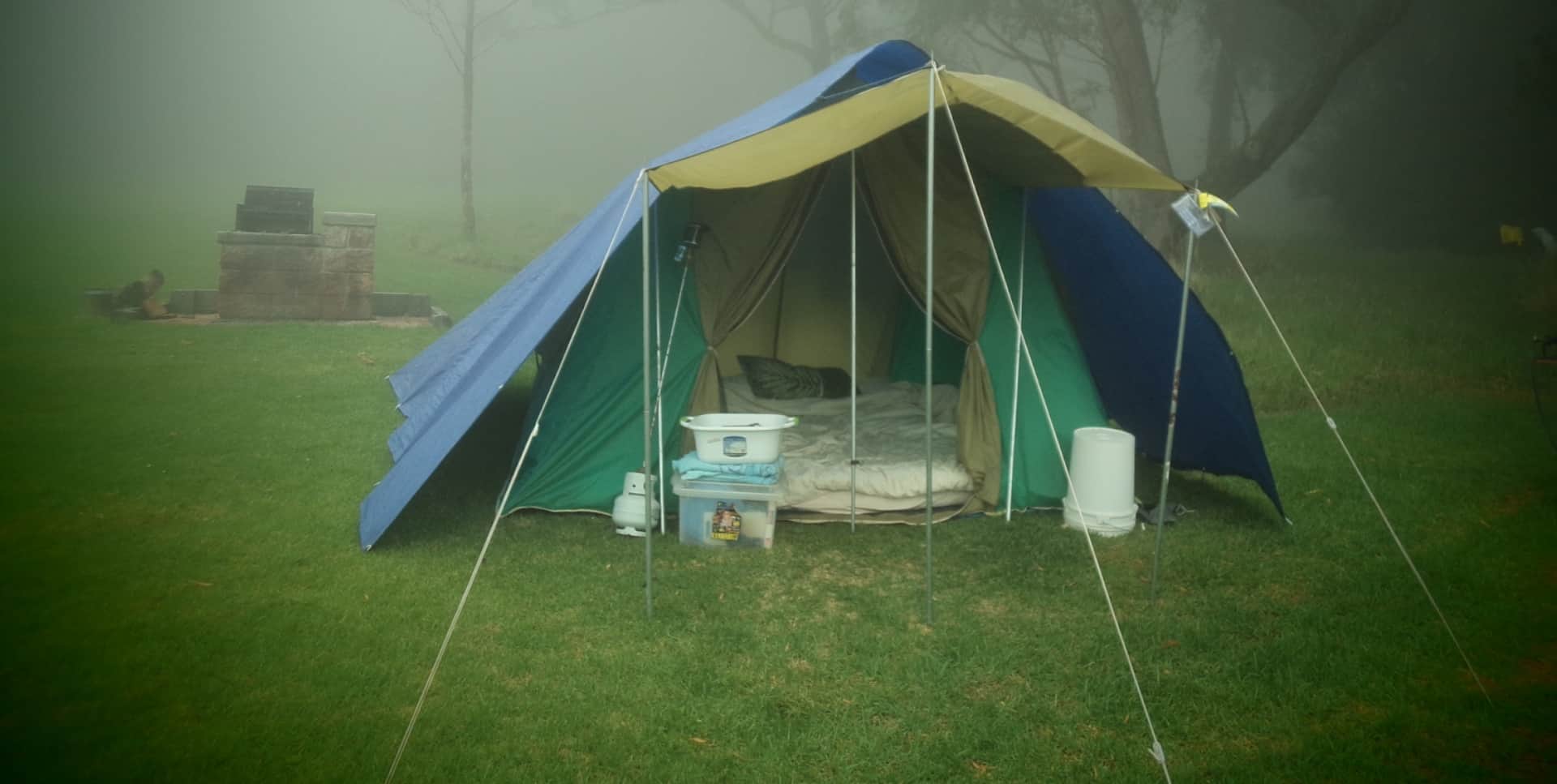You’ve ended up with a soaking wet tent after a weekend away camping, and it’s just … sitting there all sodden.
You could leave it, but that’s going to mean a moldy, rotten mess that won’t be much fun to clean up next time you go camping, or more likely, a complete replacement of the tent.
Knowing how to dry a tent fast will save you money, avoid mold and increase its lifespan. Read on to find out more!
To dry a tent, remove the rainfly, open all tent doors and vents for maximum airflow, wipe off any water with a towel, and place the tent in the sun if possible. If it’s raining, take the tent to a shelter and hang it up to dry.
How to dry a tent – 5 simple steps
- Take the rain fly off the tent and hang it over a line, branch, or pole to dry.
- Open all the doors and vents to get as much airflow as possible.
- Wipe all the water off the tent floor and walls as you can with a microfiber towel.
- If possible, place the tent in the sun.
- Repack once completely dry.
Related: Worried about heavy rain leading to a night of sleeping in a puddle? Find out what the best rain proof tent is.
Drying a tent outdoors
If you want to dry a tent outdoors, it’s best to dry the tent before you pack it up to go home.
So if it’s not raining, take off the rainfly and either hang it up as spread out as you can or place it on a dry, sunny patch of grass, rock, or even a camping table to dry.
Don’t forget to flip the rainfly over from time to time so that it dries on both sides quickly.
Get all your backpacking or camping gear out of the tent and open every window, door, and vent to allow maximum airflow through.
The airflow is critical and will make drying the tent so much quicker. Dry your clothes at the same time if they are wet too. Dry clothes and tents are lighter and easier to pack than wet ones!
If you have a free-standing tent, move it to a sunny patch to speed up the process. You can also turn a lot of freestanding tents on their side to allow the bottom to dry out. Be careful you don’t bend or break the tent poles, though.
If there is water puddled inside the tent, use a microfiber towel to wipe all the water off the tent floor and walls if necessary.
Air the tent on a sunny day
Airing a tent on a sunny day is the easiest way to do it!
Let the power of the sun do the hard work for you by simply putting the tent up in a sunny patch with all its windows, vents, and doors open once you are home or while you are still at the campsite.
How to dry a tent in the rain
You can’t dry a tent while it is out in the rain! You will need to move it to some sort of shelter or wait till the rain stops.
You’ll need to move all your gear out and either put it in the shelter or your car. Then disassemble the tent and bring it under protection and hang it up to dry.
You may need to create a clothesline or if the tent is a free-standing one, move it, still set up under the shelter, and leave it there to dry.
Again, you will need to wipe out any standing water and open all the doors, windows, and vents to get the air moving to create the evaporation of the water on your tent.
Putting your tent under a tarp is a great way to help keep your camping tent dry when you are camping in the rain!
How to dry a tent in winter
Drying a tent in winter can be a challenge, but again, airflow and a sunny spot will take care of most of the water on your tent.
Brush snow and ice off the tent before you pack it up and dry the inside with a microfibre towel. Then put it in a sunny place with a breeze if possible to finish drying out. It may take a lot longer than in the summer months.
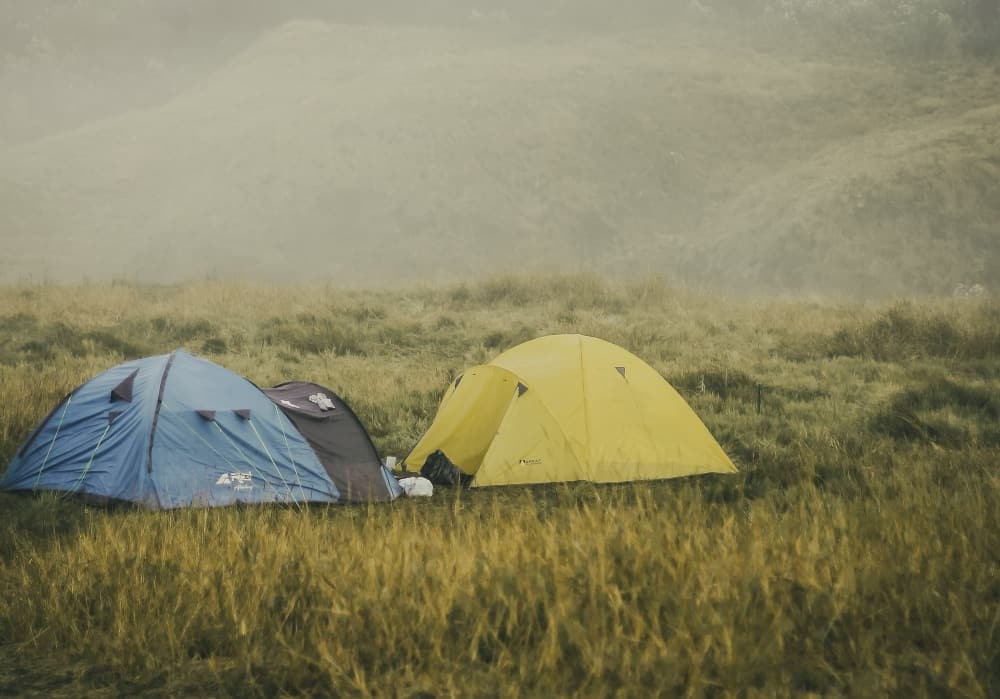
How to dry a tent indoors
Drying a tent indoors is easy enough for free-standing tents if you have enough room. Simply set the tent up in a large enough space in your house, wipe out any standing water with a microfibre towel and open up all the doors, windows, and vents.
If it’s a nice day, open your windows and doors to get the converted cross breeze through, or if it’s still raining, use the overhead fan or a floor fan directed through the tent to create the water evaporating breeze.
Drying a tent in a small apartment
To dry a tent in a small apartment, you need to get a bit creative. Again wiping out any standing water in the tent and then using any available space to hang the tent up is what’s required.
If the tent is still dripping, put towels underneath it to soak up the water.
Wherever you put it, try to open all the doors and windows of your apartment and/or set up a fan to speed up the process. You may also have to turn the tent and rain fly over and over to expose all parts to the airflow and make sure it’s thoroughly dry before you pack it up.
Try some of these ideas if you are short on space to set up the wet tent:
- Inside the shower cubicle
- Over the kitchen table
- Between two, three, or four chairs
- Over a curtain rail
- On the balcony
- Over the balcony rail
- In the garage
- At a neighbors place
- Under a pergola or patio
- On a clothesline (make sure it can handle the weight of the tent)
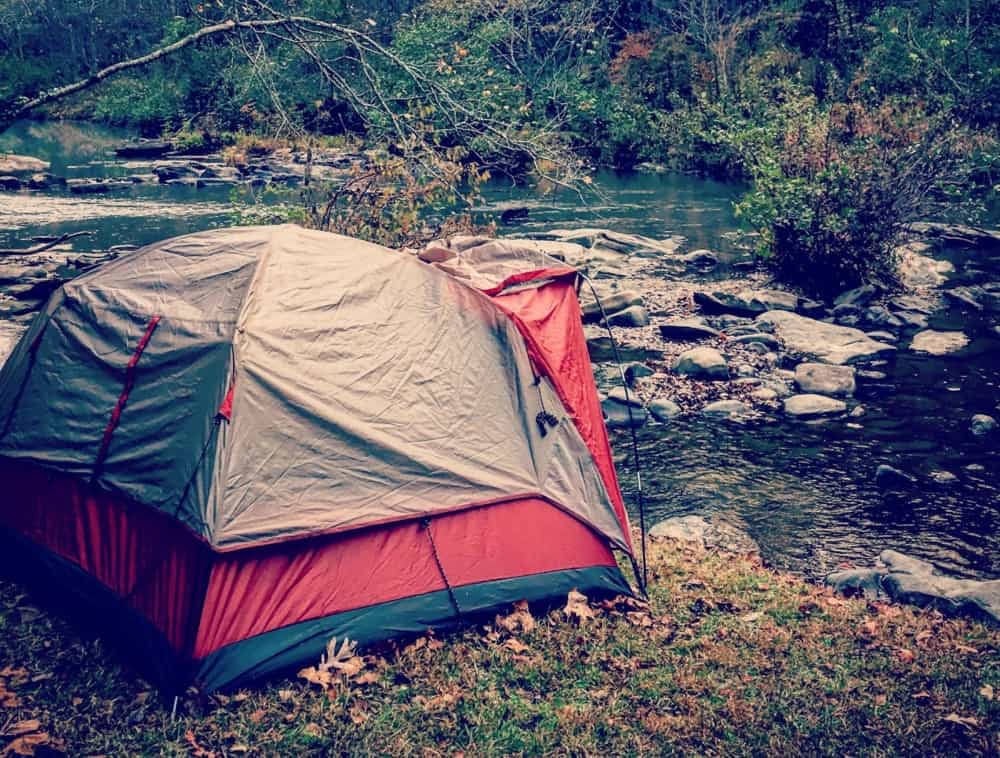
What is the fastest way to dry a tent?
The fastest way to dry a tent is to have abundant sunlight, airflow, and space! Get the tent into the warmest spot at your campsite or in your backyard.
Get some airflow by opening up the doors, and use artificial airflow in the form of a fan to move things along a bit faster.
Spread out your tent when you are drying it. If it’s pitched, make sure the guy ropes are taut, and no sagging material can harbor moisture. If you have it hanging on a line, under a shelter, or over a bush, remember to come and move it about and expose every part to the sun and the moving air to dry it as fast as possible.
How long for a tent to dry
A tent will take anywhere from half an hour to an hour and a half to dry, depending on how wet it was in the first place, whether or not there is good airflow, and the tent material.
Large canvas tents take the longest to dry, and small backpacking tents of modern materials are the quickest to dry out.
Can you dry a tent in the dryer?
No. Not ever. Do not put your tent in a dryer.
Dryers both tangle the guylines into Gordian knots that may never come undone AND they may melt your nylon material.
The heat will un-waterproof the seams, and even if you put it on a low heat setting, it will warp and stretch the fabric so that your tent doesn’t sit right the next time you put up your tent.
Canvas tents are usually too big to go into a domestic dryer, but those with natural fibers and commercial dryers at the laundromat are pretty darn hot and may also affect the shape and waterproofing of your tent.
Just don’t do it.
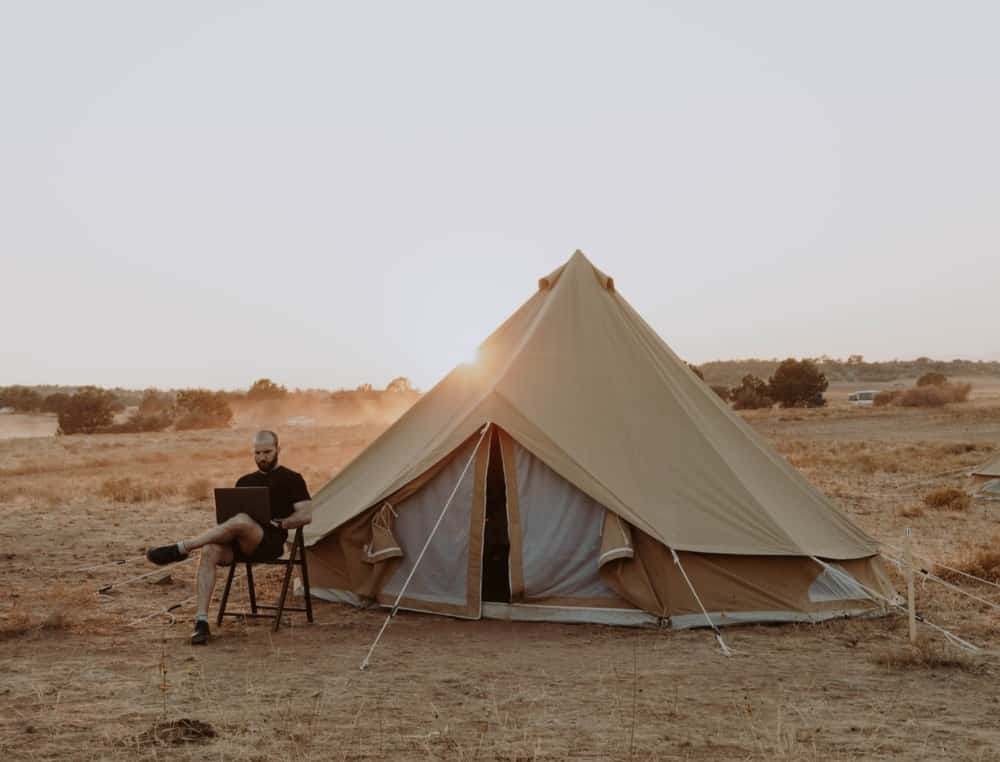
How to dry a canvas tent
Drying a canvas tent is pretty similar to the other tents. It just takes a lot longer to dry. Wipe out the visible water and then get the air flowing through it the best you can. It pays to have your canvas tent standing when you dry it as they are very heavy when they are wet.
Canvas is more susceptible to mold and mildew as it’s made from a natural material, cotton, so you need to make sure that it is adequately dry before you put it away.
Putting away a wet tent can lead to mold and mildew
Molds and mildews are fungi types that grow in damp places that are flat like doors, windows, and walls of houses – and tents!
You will have seen it as a white or grey powdery substance that has a very characteristic smell.
Mold and mildew will affect your tent’s waterproofness and trigger any allergies you might have for things like this.
All tent types can be affected by molds and mildew but ones with natural fibers in them tend to get more damaged faster.
Drying your tent out before storing it for the next trip is a vital part of tent care. Don’t skimp on this step unless you want to buy a new tent the next time you go camping.
Consider it one of the many tasks that there are to do on a camping trip and enjoy the process of making good gear last.
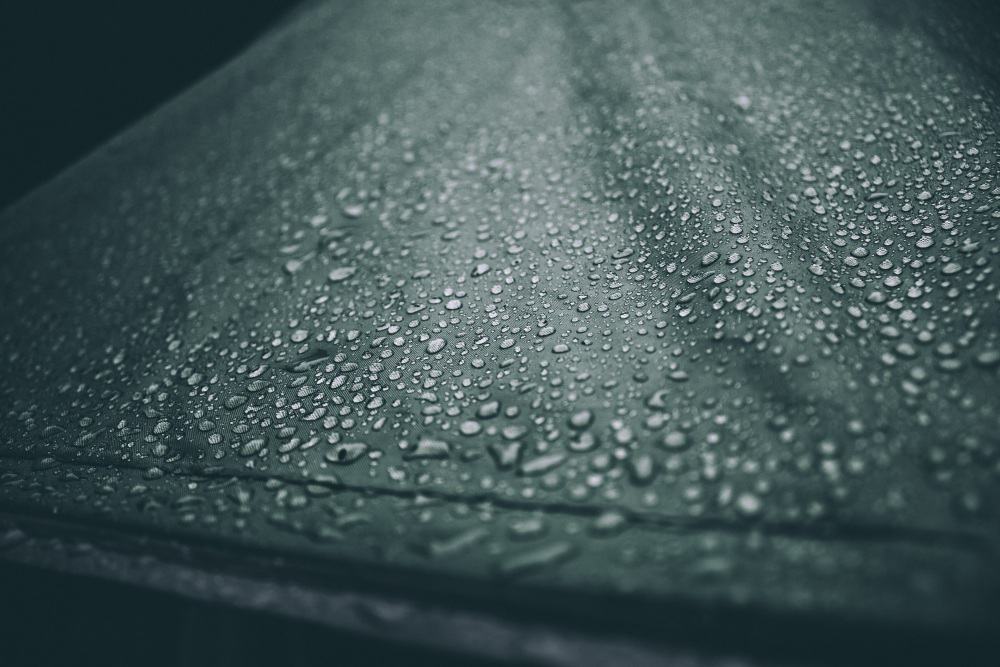
If you’re a little worried about how damp you might get before you go on your camping trip, you can look into cans of spray waterproofing for the fly, and you can also get a tube of seam sealer and make sure you are as waterproof as you can be before you go.
Grab a few microfiber towels and enjoy the camping trip, no matter the weather.
FAQ
How do you dry a tent?
How do you dry a wet tent fast?
Can you dry a tent in a dryer?
How long can you leave a tent wet?
What happens if you put a tent away wet?
Happy Camping! 😊
Back one: Make sure you don’t get dehydrated. Find out how much water you should bring for backpacking.
